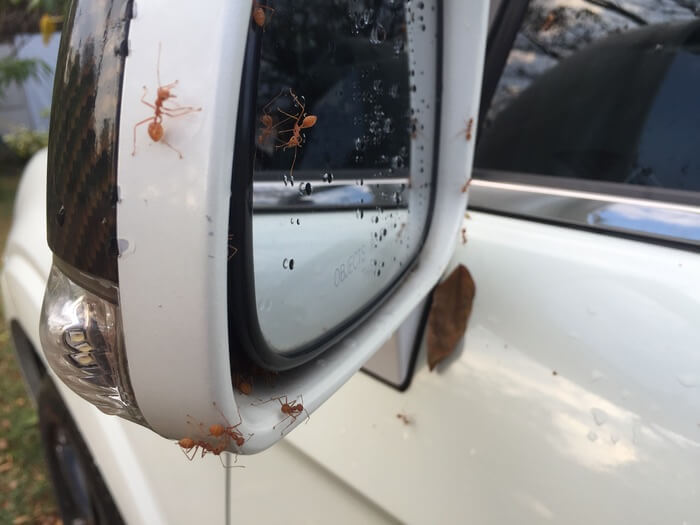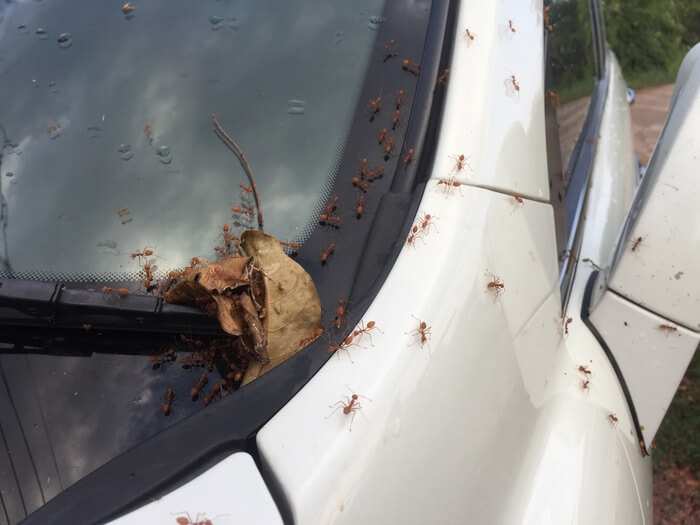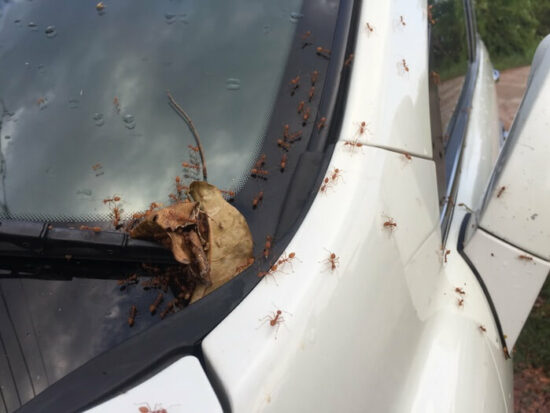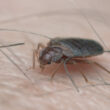Once you know how to get rid of ants in your car, you’ll be shocked that you ever let any inside it in the first place! While these insects in your vehicle can be tricky if you’re unsure of what to do, it’s actually rather simple once you have a plan.
In this guide we’ll teach you how to get ants out of your car, why they’re inside it, and also give you some alternative methods to get them out naturally.
Table of contents
Why Are There Ants In My Car?
Having pests of any kind in your vehicle can be alarming. However, ants in your car are one of the most challenging kinds to deal with.
Not only can ants bite you mid-drive, but some species are known to chew through wires and cause physical damage to your car. Ant infestations are not something you want to ignore.
All that said, why do ants invade cars in the first place?
Whether they live in the cabin or make their way into an exterior panel, most ants invade cars by chance. These insects are on a constant search for food. They’re attracted to a wide range of smells and can often sense crumbs from great distances.
- Kills common household ants including acrobat, crazy, ghost, little black, odorous house, pavement, and other sweet-eating ants
- As worker ants discover the bait, they share it with the rest of the colony to eliminate them all
- You should see a significant decrease in the number of ants visiting the bait stations within just a few days
- Place stations near areas where you’ve seen ant activity

If your car contains even a little bit of food, ants can (and will) find it. Usually, scout ants are the ones to make their way into your vehicle first. Once they find those valuable food resources, they’ll establish a scent trail of pheromones.
The pheromone trail directs worker ants to your car, resulting in a grand procession of food delivery!
Quick Tip: Contrary to popular belief, ants very rarely set up colonies in vehicles. Your car isn’t conducive to long-term living. It’s merely a temporary stop that you just so happen to come across!
Types Of Ants That Commonly Get Into Cars
There are many different kinds of ants out there. The exact species that get into your car largely depends on your local species.
Any type of ant that resides near your parking area can make their way into your car.
Some of the most common species are:
- Black ants
- Carpenter ants
- Odorous ants
- Fire ants
- Pavement ants
It may help to familiarize yourself with local ant species. Understanding your insect enemy can give you more insight into how to get them out of your car.
Not all ants consume the same thing. For example, most ants prefer to eat sugary snacks. Others gravitate towards protein-based foods. Knowing the difference could guide your eradication efforts later on!
How To Rid Of Ants In Your Car
Learning how to get rid of ants in your car shouldn’t be challenging, but you need to have a sense of urgency.
After you spot these bugs in your ride, it’s important to act fast! Failing to address the problem can lead to a much bigger infestation in the coming days.
Fortunately, there are many things you can do to get rid of ants in your car.
1. Park Your Car Somewhere Else
The first thing you should do is move your car to another location. And when you do that, take a minute to look around the existing spot to see if you were parked under a tree or close to an ant hill.
Location is a big deal for ants. While they’re resilient enough to travel pretty far from the colony, they’re more efficient when staying nearby.
The fact that you parked close to the ant colony made your car a target!

Move your car to a distant location that’s nowhere near other colonies. You also want to relocate the car a pretty good distance from the last spot.
Quick Tip: Remember, ants leave behind a pheromone trail. If you only move the car a few feet over, the ants can still sense that trail and make their way back into your car. Move the vehicle out of range!
Parking in a different spot serves a couple of purposes. For one, it prevents any more ants from getting in. As long as you don’t move close to another colony, relocation will stop the invasion from getting bigger.
Secondly, the move will encourage the existing ants to get out of your car. Once the food source is depleted or removed, the ants will have no reason to stick around (especially since they’re cut off from their colony). That means they may leave of their own volition.
2. Clean The Inside Of Your Car
Next, you need to clean every inch of your car’s interior. The reason those ants came in the first place was that they found food. That makes this one of the most important steps when it comes to getting ants out of your car.
It’s not uncommon to eat in the car or leave behind candy wrappers. There’s nothing wrong with you and your family enjoying food on the go. However, you need to make sure that you pick up all food remnants you leave behind.
Start by removing all the food wrappers and trash. While they seem empty, packaging can still harbor smells.
Then, vacuum up all soft surfaces. Use a hose and some crevice attachments to get into every little nook and cranny. Ants can navigate through tiny voids, so don’t assume that those difficult-to-reach spots are clean. Be thorough and take the time to get everything!
After that, wipe down the dashboard and all other hard surfaces. There could be some dried messes and leftover smells. A multi-purpose spray or wipe can get rid of all that. Plus, it will eliminate any pheromone trails that will lead other ants into your car.
3. Wash The Outside
After you finish cleaning the inside, focus your attention on the exterior.
Give your vehicle a thorough wash! Use a decent amount of water pressure and soap to get it sparkling.
Washing the exterior can remove any ants that transitioned to the outside. Clean all possible hiding spots. That means hitting the undercarriage, wheel wells, and hood.
And don’t forget about the wheels!
The wheels are often the first point of contact for ants. It’s how they crawl into your car, which makes it an important part of their overall migration. Cleaning the tires will also remove any scent trails.
Quick Tip: If you use chemical tire cleaners, it may even deter future ants from climbing up.
4. Place Ant Traps Inside Your Car
Ant traps aren’t just for your home. They’re also a great way to get rid of ants in your car.
- Kills common household ants including acrobat, crazy, ghost, little black, odorous house, pavement, and other sweet-eating ants
- As worker ants discover the bait, they share it with the rest of the colony to eliminate them all
- You should see a significant decrease in the number of ants visiting the bait stations within just a few days
- Place stations near areas where you’ve seen ant activity
Bait traps work differently than contact-based insecticides. Instead of killing ants immediately, traps work slowly over 24 to 48 hours.
At the heart of the trap is food-based bait.
Here’s where knowing what kind of ant species you’re trying to get rid of comes in handy. Traps are available with both sweet and high-protein bait foods. That way, you can pick up products that will work on the ants you’re attempting to kill.
The food encourages ants to eat the bait. But more importantly, it causes scout ants to call in reinforcement to bring the food back to the nest.
Little do these insects know, but the bait is laced with toxic ant poison. By the time the insects start dying off, many in the colony have already had a taste!
Traps can kill off entire populations. That includes the queen!
Place several ant traps throughout your car’s interior. Make the food accessible to any ant that enters. In a few days you should see a dramatic decrease in ants. Some people like to place ant traps near the outside of their car as well, which definitely doesn’t hurt!
Tricky Locations Within Your Car
Unfortunately, getting ants out of your car isn’t always cut and dry. Your vehicle is a complex piece of machinery with tons of tiny voids for these insects to hide.
Bait can do a lot to bring ants out and kill them. But sometimes, you’ll need to get a bit creative to kill ants in tricky spots. Here are some common spots and what you can do to get rid of the ants that hide in them.
Door Frames & Panels
Most car doors are relatively hollow. They might hold several mechanical components and window mechanics, but the space between the interior panel and the exterior shell is open and perfect for ants.

The best way to get ants out of this area of your car is to use an insecticide spray.
Remove the latch portion. Called the striker, it’s that metal piece with a U-shaped bar. You can usually remove the striker with a flathead screwdriver.
Once you have access to the panel, spray the insecticide liberally. Make sure to wear some mouth and nose protection!
Dashboard
The dashboard is even more complex than the door. While you can remove panels and use spray, it’s better to set up traps nearby.
Your dashboard is home to a lot of electrical components and wiring. If you use spray, you risk causing permanent damage that will cost you more to repair.
Because of this, traps are usually the best option you have.
Engine
Believe it or not, ants can invade the engine as well. There’s a lot in there that could attract them! For example, antifreeze contains ethylene glycol. The ingredients make the fluid sweet (and appealing to these little bugs).
Quick Tip: A coolant leak is one of the most common reasons for finding ants in your car engine.
Beyond fixing any leaks, the best way to get ants out of this area of your car is by using a fogger. Again, spraying in random spots in your engine could cause trouble.
Put your car in an enclosed garage and set up a fogger. Close the garage door and let the fogger work its magic for a bit.
Fuel Door
The fuel door is another interesting spot in your car where ants can end up. You might see ants crawling up the wheel well to gain access to fuel filler.
Oftentimes, it’s the security that attracts ants here. The insects are small enough to fit around the fuel door and stay safe from would-be predators (in between their trips to pick up food).
You don’t want to spray anything into your fuel tank. Again, the best option here is to use a fogger.
Seats & Upholstery
It’s not uncommon for ants to hide inside seats and around upholstered areas of the cabin. These spots are notoriously difficult to get them out of.
We recommend using a high-powered vacuum and a steam cleaner. Lift rugs and remove all bits of trash that you can.
Quick Tip: If possible, temporarily remove the seats entirely. That way, you can gain access to those hard-to-reach spots. Use the steamer liberally and follow up with the vacuum to remove dead ants.
How To Get Rid Of Ants In Your Car Naturally
Prefer a more natural and eco-friendly solution to your problem? You don’t have to rely on harsh chemicals to deter or get rid of these ants. Instead, you can try the following methods.
Sprinkle Spices
Ants have a strong aversion to many pungent aromas. They hate spices and will often steer clear of anything that’s aromatic.
Use this to your advantage and sprinkle some spices around your car’s interior. You can use many different spices.
The go-to for most is cinnamon. Cayenne pepper, cloves, and garlic work as well. The same goes for herbs like mint!
Make A Vinegar Spray
Vinegar works on the same principles as spices. Ants hate the stuff! However, it also does a great job at removing pheromone scent trails.
Create a spray solution of one part vinegar and one part water. If you want to go the extra mile, you can also add a few drops of essential oil.
Spray the vinegar solution throughout the interior of your car and use it to wipe down surfaces. This should help you get rid of the ants in your car in no time!
Use Chalk
Did you know that ants dislike chalk? Some believe that this is because it interrupts their scent trails. Others think that the fine powder agitates the senses.
Whatever the case may be, you can use chalk as a natural way to deter and get rid of ants in your car. Draw circles on the pavement around your tires to keep them away.
Try Diatomaceous Earth
Diatomaceous earth is a fine powdery substance that dries out ants to kill them. It’s all-natural and doesn’t take long to work. Plus, it’s cost-efficient and readily available.
Sprinkle the powder directly on the ants in your car. You can apply it to floors and seats, too. Let the powder sit for several minutes before vacuuming it up.
Ways To Prevent Ants From Getting Into Your Car
After you deal with your existing problem, you need to be proactive to prevent future ant infestations in your car.
Ants can easily return if the conditions are right.
To keep them away, clean your car regularly. Pick up trash and don’t let crumbs accumulate.
Also, clean up liquid messes. Standing water or moist upholstery attracts ants.
It’s a good idea to keep some basic cleaning supplies in your car at all times. You can get a miniature vacuum for those on-the-go messes and moist towels to wipe up spills.
Finally, be mindful of where you park. Steer clear of known ant colonies. Park the vehicle away from trees, large grassy lawns, or heavily wooded areas.
Try to keep your car on the pavement or in an ant-free garage when possible.
Closing Thoughts
Now that we’ve taught you how to get ants out of your car, there’s really no reason for you to have an issue with these little insects again! As long as you do a thorough cleaning and use the recommended methods above, getting rid of them shouldn’t be a problem.
If you’ve tried everything and still have pesky ants in your car, let us know. We’re always happy to help our readers troubleshoot!



